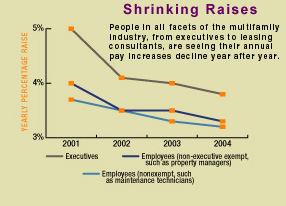Healthy Employees For many corporations, rising health care costs and insurance premiums have become a significant financial issue. That’s the case for multifamily companies as well—the benefits-related results of the NMHC survey follow general business trends.
Medical benefit costs in 2003 averaged $3,271 per multifamily employee, a 34 percent rise over the 2002 average of $2,167.
These are lower than the per-employee costs for comparable positions in other industries as well, according to
P. Jaine Jacobs, survey group manager with Watson Wyatt Data Services, a human resources data consulting firm based in New Jersey. Those figures are $4,678 per employee for general industry employees and $3,840 for the retail and wholesale sectors.
Still, these costs will continue to go up for multifamily companies. In 2004, per-employee health care costs for apartment companies are projected to rise 11.5 percent, a figure very close to national statistics for employers overall. According to a recently released study of randomly selected public and private companies done by the Kaiser Family Foundation and the Health Research and Educational Trust, employer-sponsored health insurance premiums increased by 11.2 percent in 2004. That’s down slightly from the 13.9 percent spike in 2003, but it’s still the fourth consecutive year of double-digit cost increases.
“It’s definitely a concern. Like most companies, we’ve had increases in benefit costs for the past three years,” says AvalonBay’s Hollinger. “The implication is very real, because there are other benefits that we would like to offer, such as long-term care or child care. However, we have to adjust our priorities given the medical benefit cost increases.”
The unpredictability of medical plan costs adds to the employer burden because they can be difficult to budget, Hollinger says. “As our collective use of medical care and the costs associated with malpractice insurance increase, claim expenses have also increased. These costs are passed along to the employer, and therefore the employee, with very little ability to hold down those increases,” she says. “We’ve examined plan changes in eligibility, prescription drug coverage, doctor office and emergency room co-pays, et cetera, to help in offsetting overall increases in medical plan costs.”
